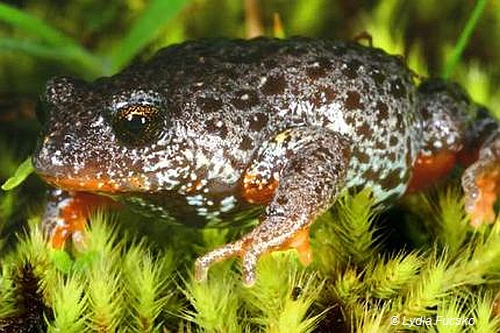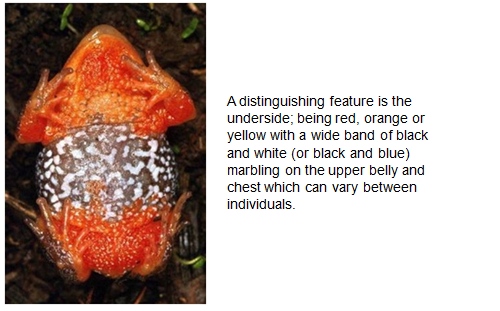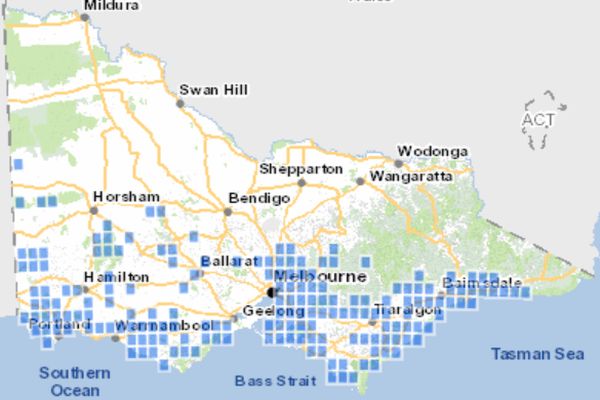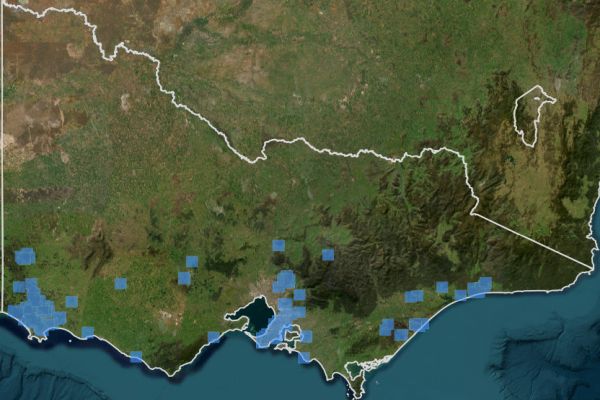Southern Toadlet
Southern ToadletPseudophryne semimarmorata | |
|---|---|
| Kingdom: | Animalia |
| Phylum: | Chordata |
| Class: | Amphibia |
| Order: | Anura |
| Family: | Myobatrachidae |
| Status | |
| World: | Least concern (IUCN Red List 2025) |
| Australia: | Not listed (EPBC Act) |
| Victoria: | Endangered (FFG Threatened List 2025) |

The Southern Toadlet Pseudophryne semimarmorata also known as the Marbled Toadlet is a small toadlet endemic to south-eastern Australia, being found in southern Victoria, eastern and northern Tasmania and south-eastern South Australia, however this species has not been recorded in South Australia’s frog census since 1997 (Walker 2003).
It is one of several species of toadlets in the genus Pseudophryne and is related to the Brown Toadlet Pseudophryne bibronii (endangered in Victoria) and Pseudophryne dendyi (data deficient in Victoria) (DSE 2013).
The Southern Toadlet is only 2 to 3 cm in length, dark brown to olive green above with black warty blotches.

Image Copyright: Lydia Fucsko
The underside is smooth in females and granular in males. Its toes are not webbed and there is a visible coloured gland at the base of each hind leg. Its movement tends to be walking rather than hopping. The call is very similar to the Bibron’s Toadlet Pseudophryne bibronii. The best way these two species can be identified from each other is by capturing the frog and looking at the belly markings, the Southern Toadlet having an orange or yellow mottled underside.
Distribution

In Victoria, the Southern Toadlet is mainly found on and south of the Great Dividing Range although there are records as far north as the Little Desert. Most records are confined to areas of Public Land.

Ecology & Habitat
The Southern Toadlet is generally found at lower elevations in damp areas usually under leaf litter, logs or rocks. It is recorded from forests, woodlands, heaths and grasslands but not necessarily near permanent water.
The Southern Toadlet can live for at least 10 years and has a very small home range of about 5 metres from the breeding site.
Breeding
The breeding season extends from late summer to early winter. Males create burrows in areas that will flood after rain from which they call, usually from late March to early May. Females lay eggs in burrows or shallow depressions created by the males. Eggs are large (up to 6mm in diameter) and pigmented (Martin and Littlejohn 1982); they are laid in loose clutches ranging between 50-170 eggs (Gillespie et al 2004). During periods of high rainfall the hatching tadpoles can be washed into larger pools and wetlands. By late spring into summer the tadpoles undergo metamorphosis from tadpole to small toadlets.
Chemical defense
Whilst many frog species store compounds in their skin, apparently for chemical defence against predators, these compounds are usually sequestered through dietary sources such as ants, beetles and millipedes. Unique to Pseudophryne species, pseudophrnamines, a class of indolic alkaloids, appear to be produced internally, either by the frog itself or by symbiotic organisms within the frog (Smith et al 2002).
Population Status
There is every indication that the Southern Toadlet is a species in decline. Where monitoring has been undertaken i.e. South Australia; the Southern Toadlet was not recorded in the state’s frog census over a five year period 1998-2002 (Walker 2003). The population trend for this species is decreasing (Gillespie et al 2004, FAN 2005) although the current population size is uncertain.
The conservation status of the Southern Toadlet was re-assessed from Vulnerable in 2013 (DSE 2013) to Endangered in 2021 – It is still considered Endangered under the Flora and Fauna Guarantee Act Threatened List Victoria (DEECA 2025).
Without comprehensive surveys across its range it is difficult to fully determine the rate of decline of the Southern Toadlet in Victoria but a number of surveys in recent years indicates a loss in areas where previous records existed.
In March 2010, surveys were carried out to determine the status of the Southern Toadlet in areas affected by the 2009 Kilmore East-Murrindindi Black Saturday fires in Victoria. Out of 106 surveysites only one Southern Toadlet was detected despite surveys being conducted in burnt and unburnt areas which were known to previously support this species (Howard et al. 2010).
Climatic influence on breeding success
A study of Southern Toadlets in south-west Victoria in 2010/11 looked at how climatic changes may have impacted on the success of the breeding season. The Southern Toadlet was once widespread in south- west Victoria but over the last 40 years there has been a severe decline in the population.
Males start calling after the first autumn rains and stop calling when nights get below 10°C. By looking at climatic records it was found there have been a number of years in which the arrival of autumn rains has been late and night time temperatures have dropped below 10°C. Under these conditions the success of the breeding season would have been limited. Ideal conditions are when the autumn rains commence in mid March and the night time temperatures remain above 10°C from March until May. (Yoni Tiljak Hon. thesis, LaTrobe University, Victoria, Australia).
In the last decade populations of Southern Toadlets near Healesville have completely failed to recruit; egg nests either desiccated or hatching occurred but the failure of follow-up rain resulted in the drying of nest sites (C. Cleeland, unpublished data). In 2009, there was no recruitment from a population of Southern Toadlets in Donvale, east of Melbourne. At that site ponds dried up with early stage tadpoles still present, and in 2009 every nest at the Healesville population desiccated before tadpoles hatched (C. Cleeland, unpublished data). (Howard et al. 2010).
Threats
A major threat to this species is a lack of data on the species ecology and status of populations.
Habitat loss - the clearing of bushland, scrub and grassland for housing developments, intensive agriculture and overgrazing impact on the Southern Toadlet.
Changes to hydrology - construction of new roads and tracks which changes natural flow; lowering of water table through groundwater use.
Habitat degredation - disturbance from logging, burning and firewood collection can also damage habitat.
Environmental factors -rising salinity, agricultural pesticide spraying and disease could be playing a part but their impact is unknown at this time.
Climate change - altered patterns of rainfall impacting on availability of water during breeding season.
Chytrid fungus - this has been identified as a major threat to frog populations worldwide. It has caused decline and extinctions of many frog species. Chytrid attacks keratin which is found in the mouth parts of tadpoles and the skin of adult frogs. It prevents tadpoles from feeding and prevents the uptake of moisture and oxygen from the skin of adult frogs effectively dehydrating the frog. Chytrid fungus is spread by the movement of infected frogs and also in water.
Conservation & Management
The conservation status of Southern Toadlet was re-assessed from Vulnerable in 2013 DSE 2013) to Endangered in 2020 as part of the Conservation Status Assessment Project – Victoria (DELWP 2020).
The collection and analysis of accurate data concerning the existing population size and distribution is a high priority. It is only possible to create a meaningful management plan, or establish the level of management required once a more precise understanding of existing population dynamics is gained.
Surveys techniques - results from surveys conducted outside of April / early May need to be interpreted cautiously; surveys outside of this period may fail to detect toadlets even if they are present, and should involve repeated visits over the season, or at least over consecutive seasons (Howard et al. 2010).
Suggested Management Actions
Conduct targeted surveys to determine the population dynamics of the Southern toadlet. Gather accurate data so that a meaningful assessment of current status can be determined.
Assess the relative importance of the Victorian population in relation to those of Tasmania and South Australia
Prepare a management plan based on the findings of surveys. This may include changes to conservation status if population is shown to be lower than estimates.
Fire management - is recommended that where possible pre-fire surveys be conducted within the range of Southern Toadlet. Surveys are best conducted in April /May and should involve repeated visits over the season (Howard et al. 2010).
References & Links
Cogger, H.G. 1986. Reptiles and Amphibians of Australia. 4th Ed. Reed New Holland, Sydney
DELWP (2021) Flora and Fauna Guarantee Act 1988 - Threatened List - June 2021, Department of Environment Land Water and Planning, Victoria.
DSE (2013) Advisory List of threatened vertebrate fauna in Victoria 2013, Department of Environment, Land, Water & planning, Victoria.
Frogs Australia Network (FAN) 2005. Australian Frog Database. Pseudophryne semimarmorata.
FFG Threatened List (2025) Flora and Fauna Guarantee Threatened List, March 2025, Department of Energy, Environment and Climate Action (DEECA). FFG Threatened List
Graeme Gillespie, Peter Robertson, Harold Cogger (2004). Pseudophryne semimarmorata. In: IUCN 2009. IUCN Red List of Threatened Species. Downloaded on 11 May 2016
Howard, K., Cleeland, C. and Clemann, N. (2010). Assessment of the status of the threatened Bibron’s Toadlet and Southern Toadlet in areas affected by the Kilmore East-Murrindindi fires: Black Saturday Victoria 2009 - Natural values fire recovery program. Department of Sustainability and Environment, Heidelberg, Victoria. pdf
IUCN (2024) IUCN SSC Amphibian Specialist Group. 2022. Pseudophryne semimarmorata. The IUCN Red List of Threatened Species 2022: e.T41051A78436624. https://dx.doi.org/10.2305/IUCN.UK.2022-2.RLTS.T41051A78436624.en. Accessed on 19 December 2024.
Littlejohn, M. J., Davies, M., Roberts, J. D. & Watson, G. F. 1993. Family Myobatrachidae. In: Fauna of Australia. Vol. 2A Amphibia and Reptilia (Ed. by C. J. Glasby, G. J. B. Ross & P. L. Beesley), pp. 41–57. Canberra: Australian Government Publishing Service
Martin, A.A. and Littlejohn, M.J. 1982. Tasmanian Amphibians. University of Tasmania. Hobart
Smith, B. P., Tyler, M. J., Kaneko, T., Garraffo, H. M., Spande, T. F. & Daly, J. W. 2002. Evidence for biosynthesis of pseudophrynamine alklaloids by an Australian Myobatrachid frog (Pseudophryne) and for the sequestration of dietary pumiliotoxins J. Nat. Prod. 65, 439–447
VBA (2025) Victorian Biodiversity Atlas, Department of Energy, Environment and Climate Action (DEECA), Victoria.
VVB (2025) Visualising Victoria's Biodiversity map portal.
Walker, S. 2003. Frog Census 2002. Environment Protection Authority.

